Walls That Promote Learning
- By Michael Fickes
- 06/01/18

PHOTO © REDPIXEL.PL
Today, when a college or university renovates classroom buildings or builds ne academic buildings, there is a newly flexible design element that can be taken advantage of: the walls.
The heretofore staid, never-changing building component—walls—has now evolved into an element that can contribute greatly to the functional design of classroom buildings. Time was, cinderblocks and upholstered partitions composed classroom walls. No longer. Today, walls feature moveable panels; integrated video screens; whiteboards; and vibrant, mood-affecting colors, textures, and graphics.
Brighter and more attractive walls can now help make classrooms livelier and more interesting for professors and students alike. Research suggests that interesting environments boost the performance of both instructors and students.
Such walls will also help to impress potential students (and parents) touring the campus during their search for a college or university.
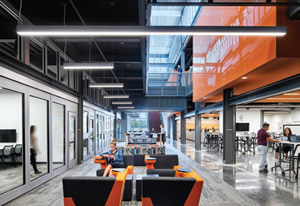
PHOTO COURTESY OF DLR GROUP, © MICHAEL ROBINSON
“Nowadays, our higher education clients regularly request moveable, writable surfaces on classroom walls,” says Shawn Gaither, AIA, LEED-AP, an architect and senior associate in the Minneapolis, MN, offices of the DLR Group.
“We’ve seen a surge in requests for writable and recordable walls, especially with the onset of collaborative teaching methods. This kind of design element has been in use by our corporate clients for a while now.”
More and more collaborative classroom spaces employ writable and recordable wall technologies, continues Gaither. Today, these technologies are givens. What is coming in the future includes the marriage of glass and electronics in classroom walls as well as in classroom furnishings.
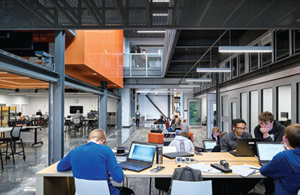
PHOTO COURTESY OF DLR GROUP, © MICHAEL ROBINSON
Full glass walls allow students and professors to enjoy the significant benefits of working in natural sunlight rather than artificial lighting, which can be oppressive.
Natural sunlight has been known for years to promote productivity among students while reducing utility costs. For instance, a 1999 study by an energy efficiency consultancy—the Heschong Mahone Group—showed that children score better on tests in naturally lit classrooms.
According to the study, test scores averaged 25 percent higher among students working under natural light. The study was conducted among elementary school children. Still, there seems to be no reason why the results should not be transferable to college students.
Electronic Walls
Today’s trend in moveable and transparent walls has drawn the interest of companies that specialize in electronically activated walls. For example, an Owens Corning company, Wall Technology, designs and manufactures acoustical wall and ceiling solutions. Products include custom as well as standard fabric/vinyl/Tedlar-wrapped acoustical wall panels as well as lines of impact-resistant panels.
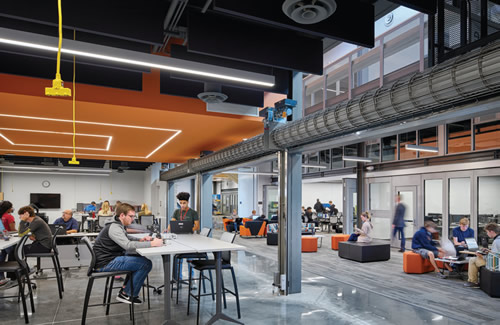
PHOTO COURTESY OF DLR GROUP, © MICHAEL ROBINSON
“Some of the most flexible learning environments rely on furnishings as well as moveable walls and ceilings,” Gaither says. “One of our moveable wall projects completed a year or so ago is the Student Cultural Center at the University of Minnesota.
“Depending on enrollment during a semester, the Cultural Center can be bursting at the seams with students. When that happens, the facilities department can move the walls to create more space. Next year, when there are fewer students, the walls can be moved again, this time to create a smaller space. So, the student union can add and subtract furnishings over time as the facility’s space grows and shrinks to fit the needs of the student users.”
The same concept works for college classrooms in which the numbers of students might ping up and down from semester to semester. Moving walls can grow to accommodate a lecture class of 100 students and then shrink to ensure that a small class of 25 students don’t feel dwarfed by a huge lecture hall.
Advanced technology walls can also accommodate the newest video technologies such as LCD projection cubes; direct-view LED screens, which provide exceptionally clear video; and organic LED (OLED) screens, which improve clarity a notch about direct-view LED.
Getting to Active Classroom Walls
Of course, in most cases, the walls of particular rooms start out as fixed sheetrock walls, continues Gaither. When a school decides to move its walls for the first time, it will incur costs—to remove the permanent walls and to purchase flexible walls.
What kinds of campus buildings can employ moveable walls?
“Old as well as new,” Gaither says.
What about the design of new buildings? Would it be a good idea to design new buildings with moveable walls?
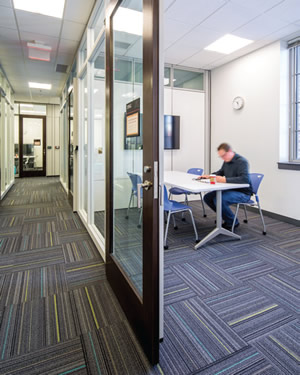
PHOTO COURTESY OF DLR GROUP, © BRANDON STENGEL
“That’s a big leap of thought,” says Gaither. “It’s difficult to think about what you will need from a building in five or 10 years. A new sheetrock wall may cost only one-third of the cost of a moveable wall. And then, of course, what if you invest in moveable walls and then don’t move them?”
So then, perhaps it is better to construct new facilities with permanent walls. If a need arises, the permanent walls can be torn out and replaced with moveable walls. Certainly not all facilities will need moveable walls—nor will all rooms within individual facilities.
What is the availability of moveable wall products in the market?
“There is not a lot of moveable wall system product in the field today,” says Gaither. “Still there is some availability. I think it is important, at least, to familiarize yourself with moveable systems.”
What Do Moveable Walls Mean to Students?
“In college, our young men and women are learning about the workplace, where workspaces change often,” Gaither says. “Work spaces are no longer cube farms with 60-inch-tall wall panels that you can’t see over. That’s what you see in the Dilbert comic strip, and that’s the past.
“Work spaces today feature low cubicles. People can easily see over low cubicle walls and see each other. This fosters collaboration, which is important in today’s workplace.”
Low cubicles also allow natural light from perimeter windows to infuse a work space. “Daylight is important,” he says. “Many workers are eager to have daylight back in their lives.”
Observers also point out that moveable walls replace older, more unpleasantlooking walls. Recall the cinderblock walls of yesterday. Upholstered moveable walls with interesting artwork and wall coverings eliminate harsh-looking cinderblock surfaces, whether the individual classroom needs to be large or small.
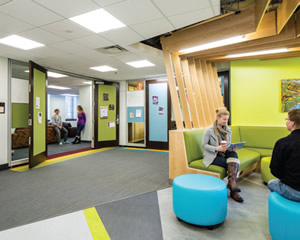
PHOTO COURTESY OF DLR GROUP, © BRANDON STENGEL
“Students and teachers need natural daylight, too. Transparency is equally important, from the point of view of safety. When we create classroom spaces, it is important to see into them. If someone is thinking about making wrong choices—damaging the technology, for instance—he or she will likely refrain if such actions must be made in full view.”
As noted, attractively designed moveable—or fixed—walls provide interesting classroom surroundings. In addition, such walls can adjust classroom size to ensure the comfort of students and teachers.
Most importantly, research shows that comfortable students and teachers perform better. Attractive, interesting, moveable walls can contribute to comfort in the classroom. What better argument is there for paying close attention to classroom walls during the design work that will guide the development of future classrooms on your campus?
This article originally appeared in the College Planning & Management June 2018 issue of Spaces4Learning.